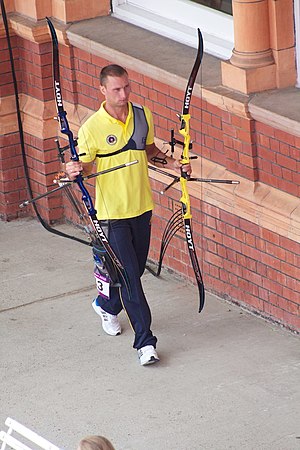
Back Arco recurvo Spanish Vastakaarijousi Finnish Busur recurve ID Arco olimpico Italian リカーブボウ Japanese 반곡궁 Korean Lenktas lankas Lithuanian Recurveboog Dutch Rekurvbue NB Arco recurvo Portuguese

In archery, a recurve bow is one of the main shapes a bow can take, with limbs that curve away from the archer when unstrung. A recurve bow stores more energy and delivers energy more efficiently than the equivalent straight-limbed bow, giving a greater amount of energy and speed to the arrow. A recurve will permit a shorter bow than the simple straight limb bow for given arrow energy, and this form was often preferred by archers in environments where long weapons could be cumbersome, such as in brush and forest terrain, or while on horseback.
Recurved limbs also put greater stress on the materials used to make the bow, and they may make more noise with the shot. Extreme recurves make the bow unstable when being strung. An unstrung recurve bow can have a confusing shape and many Native American weapons, when separated from their original owners and cultures, were incorrectly strung backwards and destroyed when attempts were made to shoot them.[1] A test performed by Hepworth and Smith in 2002 of a preparation manufactured from bovine tendon and pearl glue and used in traditional Asiatic recurve bows showed that the composite "was found to absorb 18 MJ/m3 of energy to failure, comparable to carbon fibre composites, spring steel and butyl rubber."[2]
- ^ American Indian Archery. Reginald Laubin, Gladys Laubin. University of Oklahoma Press 1980. ISBN 0-8061-1467-3 ISBN 978-0-8061-1467-5
- ^ Hepworth, D.G.; Smith, J.P. (2002). "The mechanical properties of composites manufactured from tendon fibres and pearl glue (Animal glue)". Composites Part A: Applied Science and Manufacturing. 33 (6): 797–803. doi:10.1016/S1359-835X(02)00025-8.